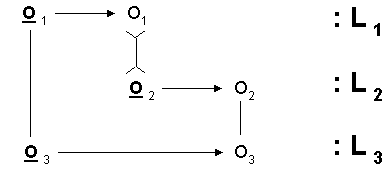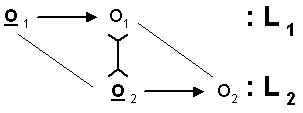|
IM KONTEXT:
|
GÜNTHER - 2000A contribution in three parts
|
|||||||||||||||||||||
|
table 1 |
 |
|
with |
|
|
it follows |
|
 |
|
One of the examples discussed by Julian Jaynes may illustrate the meaning of the symbols used in Table 1: "Consider the metaphor that the snow blankets the ground. The metaphrand is something about the completeness and even thickness with which the ground is covered by snow. The metaphier is a blanket on a bed. But the pleasing nuances of this metaphor are in the paraphiers of the metaphier, blanket. These are something about warmth, protection, and slumber until some period of awakening. These associations of blanket then automatically become the associations or paraphrands of the original metaphrand, the way the snow covers the ground. And we thus have created by this metaphor the idea of the earth sleeping and protected by the snow cover until its awakening in spring. All this is packed into the simple use of the word 'blanket' to pertain to the way snow covers the ground." In other words, what has been described in Table 1 are processes of predication where the verb (here: ´to blanket´) can be used with different meanings belonging to different contexts, respectively. If we introduce the notation of predicative logic with O(...), the predicate (the metaphier) and O the corresponding subject (the metaphorand) then Jaynes´s tells us, that we have to consider processes where O itself becomes a predicate, i.e., O2(O1(O)). As it is well known from Russell´s theory of types, for example, such an expression is not allowed because it produces logical paradoxes. If we introduce two logical domains L1 and L2 which are interrelated by special operators then the predication O2(O1(O)) can be distributed among these two (indexed) logical domains as shown in Table 2. We will call these logical domains contextures. In each contexture all logical rules hold rigorously and in addition there some new operators such as the transjunction which models transitions from one domain in the other [2].
|
|
|
Table 2a: Distributed predication on two contextures |
|
|
|
Table 2b: Composition of 2a |
|
The meaning of the symbols corresponds to the one in ( 3 ) |
Without going into details one can show that the lowest meaningful compound is composed of at least three contextures as it is demonstrated in Table 3.
 |
Table 3 |
 |
|
|
Three logical contextures : L(3) = (L1, L2, L3) |
Now we are able to see the ontological consequences which result from the mono-contextural Aristotelian epistemology. There is only one universal contexture and everything which is belongs to this contexture of objective Being. And what does not belong to it is just Nothingness. The reason for this situation is, that there is only one negation resulting in the dichotomy (duality) as it is shown in Table 4. On the one side the universe qua Being is the cause of the things and events in a physical world; on the other side the universe is the reason from which our ideas and concepts follow logically. In other words, within one contexture - especially within a mono-contextural logic conception - the universe can only be interpreted in those terms listed in the left column of Table 4. A poly-contextural epistemology allows the formal mathematical modeling of the universe as an interplay of both complementary categories, i.e., a theory of the universe which also contains subjectivity or in general mental processes.
 Table
4
Table
4
At this point it should be possible to understand the concept of a negative language. If we consider only one contexture - as it is the case in a mono-contextural epistemology - we have only one negation and all categories listed in the right column of Table 4 disappear as non-designated categories within the Nothingness. It is the physical aspect of the designated Being of the Universe which determines not only our scientific modeling but also our cultural life, our social reality where quantity dominates quality. Within a poly-contextural epistemology on the other side, both the physical and the psychical aspects of the Universe will become the topic of our scientific efforts. Mental process or quality aspects only can be modeled as discontexturalities in a multi-negational logical language as given by the poly-contextural theory introduced by Gotthard Günther and Rudolf Kaehr.
Gotthard Günther´s last publication together with some studies of Rudolf Kaehr are the focus of part2:
1. "Identität, Gegenidentität und
Negativsprache" (Gotthard Günther)
in addition we have a copy of
2. Vorwort zu "Beiträge zur Grundlegung einer operationsfähigen Dialektik" - Band 1 (Gotthard Günther) For the English speaking interested reader there is some additional material available via e-mail from : vgo@xpertnet.de
Since Günther´s work has widely been ignored by the German speaking philosophical mainstream it might be of interest to have a retrospective look on some reviews on his work.
3. Some GÜNTHER RECENSIONS:
Oskar BECKER in: Hegel Studien Bd.2 (1963) 322-325 Gotthard Günther: Idee und Grundriß einer nicht-Aristotelischen Logik. Band 1: Die Idee und ihre philosophischen Voraussetzungen. Hamburg: Meiner 1959. XXII, 417 S
Max BENSE in: Merkur 14 (II), 1960, 687-690 Grundlagenforschung und Existenzbestimmung and Nachwort zu: "Beiträge zu einer operationsfähigen Dialektik"
Werner FLACH in: Philosophischer Literaturanzeiger XIV (1961) p. 52-63 GOTTHARD GÜNTHER: Idee und Grundriß einer nicht-Aristotelischen Logik. 1. Bd.: Die Idee und ihre philosophischen Voraussetzungen. XXII; 417 S. Verlag von Felix Meiner, Hamburg 1959.
Helmar FRANK Zeitschrift für philosophiche Forschung XVII (4) 1968, 724-727
Karl-Heinz LUDWIG Pegasus als Reflexionsrest? Gotthard Günthers Theorie einer nicht-Aristotelischen Logik - Darstellung und Kritik.
The answer to the somewhat polemic criticism of Ludwig written by R. Kaehr and J. Ditterich is an excellent review and introduction into Günther´s work.
4. Einübung in eine andere Lektüre: Diagramm einer Rekontruktion der Güntherschen Theorie der Negativsprachen ( Rudolf Kaehr und Josef Ditterich)
Part 2 also is dedicated to some work of Rudolf Kaehr whose name is strongly connected with the development of the poly-contextural theory. Further studies of Rudolf Kaehr will follow within part 3.
Today we have
5. Einschreiben in Zukunft (Rudolf Kaehr)
and two articles which have been published by C. Härle in "Basler Nachrichten" and by Eva Meyer in "taz":
6. Über den Begriff der transklassichen Maschine
Zwischen den Traditionen - der deutsche Philosoph Gotthard Günther (C. Härle)
Universum-Pluriversum : Gotthard Günther, ein Denker der Zukunft
(E. Meyer)
As a special highlight we offer audio extractions from a contribution which was broadcasted by the German television (WDR 3) entitled "Freistil, oder die Seinsmaschine, Mitteilungen aus der Wirklichkeit" and an interview of Rudolf Kaehr by Sandrina Khaled - a text version which fits very well with the content of the video.
7. Über Todesstruktur, Maschine und Kenogrammatik
(Sandrina
Khaled/ Rudolf Kaehr)
8. Freistil, oder die Seinsmaschine (Thomas Schmitt/ Rudolf Kaehr)
by kind permission of director and producer Thomas Schmitt,
http://www.tagtraum.de
References
[1] Julian Jaynes, The Origin of
Consciousness in the Breakdown of the Bicameral Mind", Houghton Mifflin
Comp., Boston, 1976
![]()
[2] For more details see: R. Kaehr and E.
von Goldammer, "Poly-contextural modelling of heterarchies in brain
functions", in: Models of Brain Functions, (R.M.J. Cotterill ed.)
Cambridge University Press 1989, S. 483-497. (see also: http://www.vordenker.de/ics/poly.htm)
![]()
vordenker Contact: webmaster@vordenker.de
author contact: vgo@xpertnet.de
© E.v.Goldammer 2000, all rights reserved
Issued: March 29, 2000
Last modified (layout)
2010-12-05

